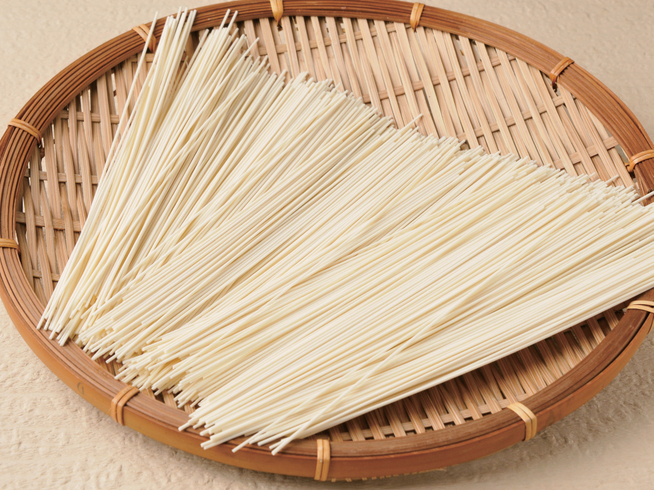
Miwa Somen Noodles, Hand-pulled Somen Noodles

NaraMiwa Somen Noodles, Hand-pulled Somen Noodles
Classification (Large)
Agricultural products
Classification (Small)
Grain products
Main ingredients used
Wheat flour, water, salt
When using downloaded images, please read the "Terms of Use" and clearly state that the source of the image is "Traditional Foods in Japan" by the Ministry of Agriculture, Forestry and Fisheries.
If the photo credits is stated, please include it as well.
Example of description
of the photo credits
Example of description when the photo credits is not stated
Source: "Traditional Foods in Japan" Ministry of Agriculture, Forestry and Fisheries
Example of description when the photo credits is stated
Source: "Traditional Foods in Japan" Ministry of Agriculture, Forestry and Fisheries
Photo credits:xxx

Photo credits:Nara Prefecture
This image isunavailable.
Region of inheritance
Sakurai City, Higashi Yoshino Village
Product overview (special characteristics and types)
Miwa Somen Noodles are made in the valleys of Nara, where winters are dry and the cold unforgiving. The manufacturing of Miwa Somen Noodles spans one to two days, putting the noodles repeatedly through a fermentation process called “Umashi,” which removes just the right amount of excess water, ensuring the noodles’ distinguishing quality: they are smooth and firm, and do not turn limp even after they are cooked.
The manufacturing and quality management standards for Miwa Somen Noodles are strict due to their long history; it is important that this quality is protected to deliver premium noodles that are thin, yet have a good bite.
History and culture
Over 1200 years ago, the son of the chief priest of Omiwa Shrine in Miwa, Nara Prefecture, took some wheat seeds and scattered them in the earth of Miwa, which was deemed suitable for growing the crop. The earth bore wheat, and it was this wheat that Miwa Somen Noodles is said to have originated from.
During the Edo period, Miwa thrived as a rest stop for long-distance travelers. It is said that pilgrims to Ise Shrine would stop by Miwa, taking the noodles with them; Miwa Somen Noodles were thus brought to places like the ancient territory of Banshu in central Japan, Shodoshima, and Shimabara in the south.
In the 28th year of the Meiji era (1895) the Miwa Somen Union was formed, allowing for more development in the manufacturing process as matters like quality control were managed more seriously. The beginning of the Taisho era to the early Showa period — the years that followed the Meiji era — was said to be the golden age of Miwa Somen Noodles.
In present-day, at Omiwa Shrine, which is deemed the birthplace of the noodles, a special divination ceremony called the Hokujosai is held annually to predict the wholesale price of the noodles for that year. At the end of summer, a Kanshasai — a ceremony for prayer and giving thanks —is also conducted at the shrine.
Production method
The manufacturing period of Miwa Somen Noodles is from December through the end of March. It is the coldest, driest time of the year. The manufacturing is done over two days — on the first, oil is applied to kneaded dough, made from wheat flour and salt water, before the dough is stretched thin. On the second day, the noodles are dried and cut before they are shipped out for sales.
Some noodle manufacturers dry out their noodles in the sun, and it is such a sight to behold that Nara Prefecture has officially designated it a Nara Landscape Heritage.
Conservation and succession efforts
On July 7, 2017, in Sakurai City of Nara Prefecture, a local ordinance called the “Sakurai City Miwa Somen Noodle Promotion-Fostering Ordinance” was enforced. Thanks to this ordinance, a host of activities related to Miwa Somen Noodles have been organized, like having businesses put up banners and posters, and the loaning out of educational materials pertaining to Miwa Somen Noodles.
In March 2016, the noodles were officially registered in the Ministry of Agriculture, Forestry and Fisheries’ GI (Geographical Indication; details here) Conservation System as “Miwa Somen.”
Main consumption method
Cooked Miwa Somen Noodles are served in a variety of dishes cold, warm, or fried. Be it cold noodles, nyumen soup noodles, aglio olio e peperoncino style, mapo eggplant gravy style, or nyumen curry noodles, there’s bound to be a way for one to enjoy Miwa Somen noodles in any season. The noodles are also popular as gifts.
At-home recipes:Yamato Mana Italian Nyumen(Serves 4)
Ingredients
Yamato Mana greens
1 head (may be substituted with spinach or komatsuna)
Sausages
4 whole sausages
Garlic
1 clove
Miwa Somen Noodles
4 bunches
(A) Water: 3 cups Tomato puree: 1 cup Instant soup stock: 5 g Olive oil: Add to taste Salt and pepper: A pinch each
How to make
Roughly cut up the Yamato Mana greens, and the sausages into small slices.
Mince the garlic.
Boil a large pot of water to cook the noodles. When they are ready, wash them in cold water, and drain.
Add the olive oil to the pot, then the garlic from Step 2. Turn the burner on. When the garlic starts to release its aroma, add the ingredients from Step 1 and fry lightly.
To the mixture in Step 4, add (A). When it starts to simmer, add the noodles from Step 3, add salt and pepper to taste.
Recipe credit : Nara Prefecture



